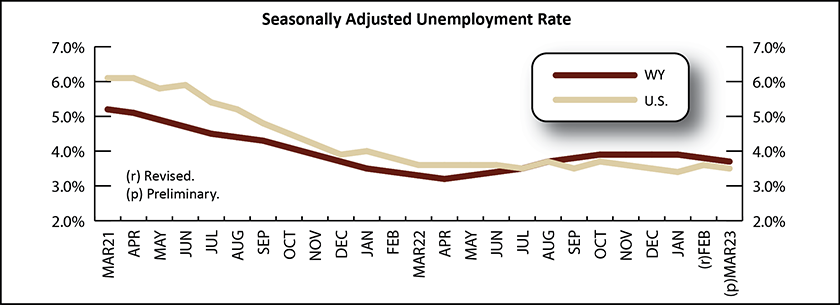Wyoming Labor Force Trends
May 2023 | Volume 60, No. 5
Click Here for PDF
Return to Table of Contents
Wyoming Unemployment Falls to 3.7% in March 2023
by: David Bullard, Senior Economist
The Research & Planning section of the Wyoming Department of Workforce Services reported that the state’s adjusted1 unemployment rate fell from 3.8% in February to 3.7% in March.
Wyoming’s unemployment rate was higher than its March 2022 level of 3.3% and slightly higher than the current U.S. unemployment rate of 3.5%. From February to March, seasonally adjusted employment of Wyoming residents rose by 1,467 individuals (0.5%) as people returned to work. Additionally, the state’s labor force, which is comprised of employed and unemployed individuals, rose by 7,027 people, or 2.4% from March 2022 to March 2023.
From February to March, most county unemployment rates remained fairly stable. Niobrara County’s unemployment rate fell from 4.7% to 3.5%. Notable increases in unemployment were seen in Washakie (up from 4.6% to 5.8%), Hot Springs (up from 3.2% to 3.8%), Converse (up from 2.8% to 3.2%), and Sweetwater (up from 4.7% to 5.1%) counties.
From March 2022 to March 2023, unemployment rates rose in 20 counties and fell in three counties. The largest increases occurred in Washakie (up from 4.4% to 5.8%) and Carbon (up from 3.7% to 4.5%) counties. Jobless rates fell in Weston (down from 3.2% to 2.7%), Campbell (down from 3.9% to 3.6%), and Converse (down from 3.4% to 3.2%) counties.
In March, Teton County had the lowest unemployment rate at 2.6%. It was followed by Weston County at 2.7% and Converse County at 3.2%. The highest unemployment rates were reported in Washakie County at 5.8%, Sweetwater County at 5.1%, and Fremont County at 4.9%.
Total nonfarm employment in Wyoming (not seasonally adjusted and measured by place of work) rose from 277,400 in March 2022 to 284,100 in March 2023, an increase of 6,700 jobs (2.4%).
R&P's most recent monthly news release is available at https://doe.state.wy.us/LMI/news.htm.




.svg)
 Wyoming at Work
Wyoming at Work